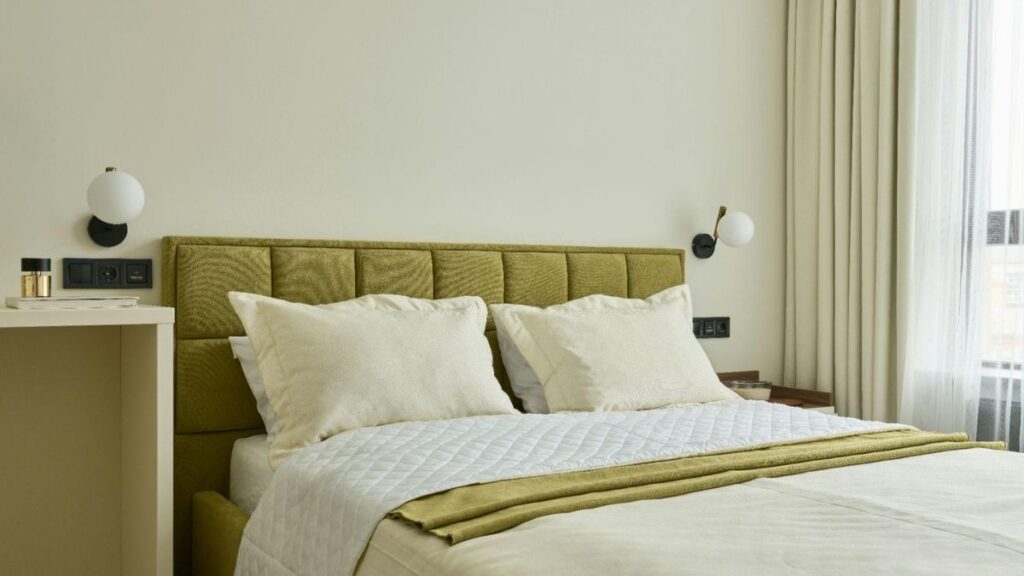Adjusting bed height can improve comfort, accessibility, and bedroom functionality.
Small space dwellers and anyone looking to maximize room layout can benefit from this subtle upgrade.
Stability, compatibility, and floor type are key factors to consider before making changes.
A tiny adjustment can unlock better storage, cleanliness, and aesthetics with the right approach.
Something is annoying about a wobbly bed. Or a bed that sits too low to the ground, making it impossible to vacuum underneath or slide in extra storage bins. Or maybe it’s just that the bed doesn’t quite align with your nightstand, leaving your phone to hit the floor every other night. These aren’t exactly life-altering issues, but they add up. And if you’ve ever muttered, “There has to be a better way,” you’re not alone adjusting your furniture for the tenth time in a week.
What’s funny is that the solution isn’t complicated. It’s small. Really small. We’re talking about a fix that could fit in the palm of your hand but completely change how your bedroom functions. The best part? You’ve probably never thought much about it before.
Why Bed Height Matters More Than You Think
It’s easy to overlook bed height when thinking about your sleep setup. Most people focus on mattresses, pillows, maybe even blackout curtains—but how high does your bed sit off the floor? That usually doesn’t make the list. Yet it’s one of those sneaky factors that affects way more than you’d expect.
For starters, comfort. Sitting down on a bed that’s too low feels like squatting into a beanbag chair—fine for a teenager, annoying for your knees. A bed that’s too high? Now you’re climbing a small mountain just to get some sleep. The right height makes transitions smoother, especially if you’ve got mobility issues or cranky joints.
Then there’s the issue of space. Urban apartments, tiny homes, and shared bedrooms all demand a smarter use of floor space. When your bed sits at the proper elevation, that forgotten area underneath suddenly turns into prime storage territory. Out-of-season clothes, shoe bins, even a slide-out desk setup? All fair game.
Let’s not forget airflow and hygiene. Beds sitting directly on the ground can trap dust, block circulation, and make vacuuming a hassle. A little elevation helps with airflow and easy cleaning, giving dust bunnies fewer hiding places.
So yeah—bed height? Kinda a big deal.
The Simple Fix That Changes Everything
Here’s where things get surprisingly satisfying. That too-low or slightly tilted bed that’s been bugging you? You don’t need a new frame or some complicated hardware store project. You just need the right little helper.
Adjusting furniture height with smart, stable add-ons has become an easy home improvement hack. Bed risers are a convenient solution when you’re looking for a practical way to support your bed, especially if you’re working with a smaller space or awkward flooring.
Not only do they give your furniture a literal lift, but they’re also versatile. You’ll find them in different materials—plastic, wood, even metal—and with varied heights to match your needs. Some come with extra features like non-slip bases or built-in power outlets. Talk about leveling up (pun intended).
And it’s not just about function. These little supports can make your room look more polished. A balanced, symmetrical bed, elevated to the correct height, makes everything else feel more intentional. Add the bonus of space underneath for bins, baskets, or even some ambient LED lighting, and you have a bedroom that works smarter and looks sharper.
In short? That tiny accessory you barely noticed can quietly revolutionize your room. Not bad for a part you could hold with one hand.
Who Should Consider This Solution
You might think, “Okay, that sounds useful… but is it really for me?” If you’ve ever wrestled with space issues, wanted more functionality in a small room, or enjoyed a cleaner, more organized space, this little fix might be what you’re looking for.
College students? Absolute no-brainer. Dorm rooms are notorious for cramped quarters, and being able to stash half your life under your bed can feel like unlocking a cheat code. Suddenly, the pile of shoes, laundry baskets, and textbooks has a place to go.
Apartment dwellers and tiny home enthusiasts will also appreciate the instant space hack. When every square inch counts, turning the underside of your bed into usable space without investing in expensive custom furniture is a significant win.
Then, some people want easier access to their beds, whether due to age, injury, or personal preference. Those few inches of lift can make a big difference in mobility. Getting into bed shouldn’t feel like an Olympic sport.
Even folks who love a minimalist, streamlined aesthetic can benefit. A bed that floats a little higher can make a small room feel more open, airier, and even taller. And when done right, those supports can be practically invisible or even stylish.
In short? If you sleep on a bed (which, let’s be real, you probably do), there’s a decent chance this upgrade is worth considering.
Things to Watch Out For When Making the Change
Before you raise everything in your bedroom like a home makeover pro, let’s talk about what not to do. Because while the fix is simple, it’s still worth doing right.
First, check the weight. Not all risers are built the same, and not all beds are lightweight. If your bed is hefty, especially with a solid wood frame or a mattress that feels forged from steel, make sure the risers you pick are rated to handle the load. Most good ones will have a weight limit listed, so don’t skip that detail.
Second, pay attention to floor type. Hardwood, tile, and even some vinyl flooring can be slippery. If your risers don’t have a non-skid base, you could end up with a bed that slowly scoots across the room over time—or worse, one that suddenly shifts when you sit on the edge. A good grip on the floor keeps everything safe and stable.
Then there’s the matter of bed frame compatibility. Some frames have oddly shaped legs or built-in supports that don’t work well with standard risers. Before ordering anything, give your bed a quick once-over to ensure everything will fit together.
And one last thing—make sure everything’s level. Using mismatched supports (or placing them unevenly) can result in a tilted bed, which can be uncomfortable and even damage your mattress over time.
The bottom line? This is a small change, but it still deserves some care. Get it right, and your bedroom will thank you for years.
Maximizing the Benefits of Your New Setup
Once your furniture’s lifted and everything feels more functional, you’ve got a golden opportunity to make the most of your new space. It’s not just about solving a problem—it’s about unlocking a better way to live in your room.
Start with storage. You’ve now got this freshly opened slice of real estate under your bed—what will you do with it? Slide in flat plastic bins for clothes or extra bedding, stash out-of-season shoes, or create compartments for organizing those random items that never seem to have a home. Just make sure what you put down there is easy to pull out and doesn’t block airflow.
This also opens the door (literally and figuratively) to better cleaning habits—no more awkward dance with the vacuum or ignoring the dust colonies under your frame. With a bit of lift, you’ll clean faster and more often, keeping things fresher and more allergen-free.
Feeling a little extra? Think creatively. Install a subtle strip of LED lights underneath the bed to create a cozy glow at night. Some people even mount under-bed drawers or roll-in shelving units. What started as a fix becomes a full-on design upgrade.
The kind of minor change creates a ripple effect: better function, cleanliness, and vibes.
Conclusion: When the Smallest Fix Makes the Biggest Difference
We tend to think fixing our living spaces means major renovations or expensive furniture swaps. But sometimes, the little things bring the most significant shifts. That overlooked piece under your bed? It’s not just hardware—it’s a way to reclaim space, comfort, and control over your environment.
It’s a reminder that clever design doesn’t always scream for attention. Sometimes, it just quietly works in the background, making everything a little easier, a little neater, and much more enjoyable. So if you’re stuck with a bedroom that doesn’t quite work the way you want, maybe it’s time to look down—way down—for the solution.







